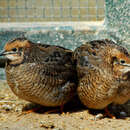pt-BR
nomes no trilho de navegação


This quail is closely related to the European Common Quail, Coturnix coturnix. In captivity, these quail will interbreed (Harper 1986) and produce fertile hybrids (Johnsgard 1988). Coturnix japonica has been domesticated since circa the 13th century (Hoffmann 1988). In their natural habitat, Coturnix japonica and C. coturnix have not been found to interbreed in areas where they are sympatric. Although these two forms are considered to be in an intermediate stage of speciation, they still warrant designation as two separate species (Johnsgard 1988).
Perception Channels: visual ; tactile ; acoustic ; chemical
With its broad breeding range, this quail is considered to be relatively secure in maintaining its populations in natural habitats (Johnsgard 1988).
IUCN Red List of Threatened Species: near threatened
There are no known adverse effects on humans by this bird.
These quail and their eggs provide food for humans (Hoffmann 1988). Japanese Quail are also frequently seen in aviaries.
These quail eat many kinds of grass seeds, including pannicum and white millet. Their diet consists of a higher degree of protein than Painted Quail as these quail will eat more small worms and insect larvae. In the summer, they will especially seek and eat a variety of insects and small invertebrates (Johnsgard 1988). In addition, they eat grit, especially egg-laying females (Lambert 1970).
In general, this quail inhabits parts of Russia (Johnsgard 1988) and eastern Asia, including Japan, Korea and China (Hoffmann 1988) as well as India (Finn 1911). It winters in China, southeast Asia, the extreme northwestern coast of Africa, and a subsaharan band north of Congo and including the Nile River valley from Egypt to Kenya. A small population has been found in Angola. Races of this quail are found in Kenya, Tanzania, Malawi south to South Africa, Mozambique, and Namibia as well as parts of Madagascar. This quail may breed in parts of Europe, Turkey, and central Asia to parts of China (Alderton 1992).
Biogeographic Regions: oriental (Native )
These quail are seen in grassy fields, on river banks, or in rice fields (Takatsukasa 1941).
Terrestrial Biomes: savanna or grassland
Average lifespan
Status: captivity: 6 years.
The Japanese Quail is similar in appearance to the European Common Quail, Coturnix coturnix. Overall, they are dark brown with buff mottling above and lighter brown underneath. They have a whitish stripe above the eye on the side of the head. Legs are orangish-gray to pinkish-gray as is the beak (Hoffmann 1988). In contrast to the males, females usually (but not always) lack the rufous coloring on the breast and black flecking or markings on the throat (Johnsgard 1988).
There are variations in plumage color. Some birds are whitish to buff with rufous to chestnut mottling above. Others have a very dark brown appearance with little to no mottling. In addition, there have been golden-brown varieties bred in captivity (Hoffmann 1988).
Wing sizes in males and females is similar ranging from 92 to 101 mm. Both male and female have similar sized tails ranging from 35-49 mm in length (Johnsgard 1988).
Average mass: 90 g.
Other Physical Features: endothermic ; bilateral symmetry
Average mass: 115 g.
As with other quail, eggs were laid at a rate of one per day (Lambert 1970), with 7-14 eggs per clutch (Hoffmann 1988). An egg averages 29.8 by 21.5 mm is size and weighs 7.6 g (Johnsgard 1988). Incubation time is 19-20 days (Lambert 1970), although clutch sizes have been associated with latitude and length of photoperiod. In Japan, clutch size is 5-8 eggs, while in Russia, clutch size is 5-9 eggs (Johnsgard 1988). The chicks are considered to be mature and able to mate after four weeks old (Hoffmann 1988).
The breeding season varies with location. In Russia, the season starts in late April and continues to early August. In Japan, nesting occurs from late in May and usually ends in August. On the rare occasion, eggs may be found in nests in September (Johnsgard 1988).
Key Reproductive Features: iteroparous ; gonochoric/gonochoristic/dioecious (sexes separate); sexual ; oviparous
Average time to hatching: 17 days.
Average age at sexual or reproductive maturity (male)
Sex: male: 52 days.
Average age at sexual or reproductive maturity (female)
Sex: female: 63 days.